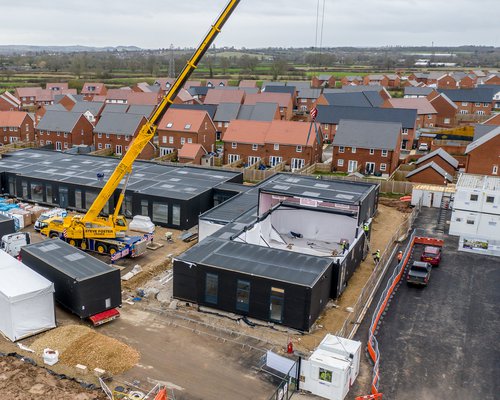Modern methods of construction are transforming Britain’s building landscape faster than ever before – but what’s driving this seismic shift in how we build? With the UK construction industry facing unprecedented challenges in housing demand, sustainability requirements, and skilled labour shortages, innovative building techniques are revolutionising how we approach construction projects. Recent statistics show that MMC adoption has increased by 40% since 2019, marking a significant turning point in British construction practices.
The Evolution of Construction: From Traditional to Modern Methods
The UK construction industry has undergone a remarkable transformation over the past decade. Traditional building methods, characterised by on-site construction, manual processes, and lengthy project timelines, are gradually giving way to more innovative approaches. This shift has been driven by several factors, including the pressing need to address the national housing shortage, meet stringent environmental regulations, and overcome the challenges of a diminishing skilled workforce. Modern Methods of Construction (MMC) represent a fundamental change in building philosophy, moving from reactive to proactive approaches, with up to 70% of construction work now potentially taking place in controlled factory environments rather than on-site.
Key Modern Construction Methods Reshaping the Industry
Off-site Manufacturing and Modular Construction
- Volumetric construction: Complete rooms manufactured off-site
- Panelised systems: Wall, floor, and roof components pre-assembled in factories
- Hybrid approaches combining various prefabricated elements
- Precision engineering reducing waste by up to 90%
- Quality control systems ensuring consistent standards
Digital Integration and BIM Technology
Building Information Modelling (BIM) has become the cornerstone of modern construction planning. This sophisticated technology enables project teams to create detailed 3D models, simulate construction sequences, and identify potential issues before they arise on site. The UK government’s mandate for BIM Level 2 on public sector projects has accelerated adoption, with 73% of construction firms now using BIM regularly. This digital revolution has led to improved coordination, reduced errors, and better project outcomes.
Advanced Materials and Sustainable Solutions
- Cross-laminated timber (CLT) for eco-friendly structures
- Self-healing concrete reducing maintenance needs
- Smart glass and advanced insulation materials
- Recycled and sustainable building components
- Low-carbon alternatives to traditional materials
The Impact on UK Construction Projects
Speed and Efficiency Gains
Modern methods of construction have demonstrated remarkable improvements in project delivery times. Studies show that MMC can reduce construction schedules by 20-30% compared to traditional methods. This acceleration is achieved through parallel working streams, where site preparation can occur simultaneously with off-site manufacturing. Weather-related delays are minimised, and the precision of factory-produced components results in faster assembly on site.
Cost Benefits and Economic Implications
- Initial cost reductions of 20-25% on typical projects
- Lower labour costs through efficient factory production
- Reduced material waste and associated costs
- Decreased site preliminaries and overhead expenses
- Long-term savings through improved energy efficiency
Quality Control and Consistency
Factory-controlled environments have revolutionised quality standards in construction. With up to 80% fewer defects reported in MMC projects compared to traditional builds, the benefits of controlled manufacturing conditions are clear. Standardisation of components, automated processes, and rigorous testing protocols ensure consistent quality across all elements of the build.
Challenges and Considerations
Implementation Barriers
Despite the clear advantages, the transition to modern methods of construction faces several challenges. Initial investment costs for factories and equipment can be substantial, and there’s often resistance to change within the industry. Planning and building regulations sometimes struggle to keep pace with innovative techniques, and the supply chain must adapt to new ways of working. However, government initiatives and industry collaborations are helping to address these barriers.
Skills and Training Requirements
- Digital skills training for BIM and virtual design
- Factory production expertise development
- New assembly techniques and methods
- Project management adaptation for MMC
- Integration of traditional and modern skillsets
The Future of UK Construction
Industry Adaptation and Innovation
The construction sector is witnessing unprecedented change, with 65% of firms planning to increase their investment in modern methods of construction over the next three years. Innovation hubs and research centres are developing next-generation building techniques, while collaboration between industry players is driving standardisation and best practices.
Sustainability and Environmental Impact
Modern methods of construction are playing a crucial role in meeting the UK’s net-zero carbon targets. Projects using MMC typically achieve 50% lower carbon emissions during construction and significantly better energy performance throughout the building’s lifecycle. This environmental advantage is becoming increasingly important as sustainability regulations tighten.
Making the Transition: Practical Steps Forward
For construction professionals and developers looking to embrace modern methods of construction, a structured approach is essential. Start with pilot projects to build experience, invest in training and development, and forge partnerships with established MMC providers. The government’s Construction Playbook and MMC framework provide valuable guidance for organisations making the transition. With careful planning and a commitment to innovation, modern methods of construction offer a clear path to more efficient, sustainable, and profitable building projects in the UK.
FAQ
What is the new style of house called?
Contemporary. Some may consider contemporary and modern architecture to be essentially the same thing. However, contemporary refers to today’s building styles, which can vary in design and appearance.
What is the modern building style called?
Modernism in architecture It was also known as International Modernism or International Style, after an exhibition of modernist architecture in America in 1932 by the architect Philip Johnson.
Sources
[1] https://www.goconstruct.org/educational-resources/learn-about-construction/modern-methods-of-construction
[2] https://www.zurich.co.uk/news-and-insight/what-are-the-types-of-modern-methods-of-construction
[3] https://en.wikipedia.org/wiki/Modern_methods_of_construction


Leave a Reply